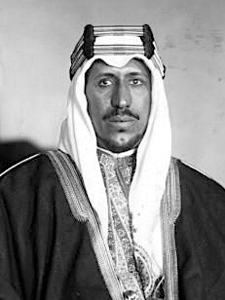Saud of Saudi Arabia facts for kids
Quick facts for kids Saud |
|||||
|---|---|---|---|---|---|
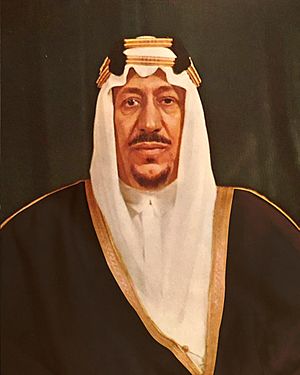
Official portrait, 1960
|
|||||
| King of Saudi Arabia | |||||
| Reign | 9 November 1953 – 2 November 1964 | ||||
| Bay'ah | 9 November 1953 | ||||
| Predecessor | Abdulaziz | ||||
| Successor | Faisal | ||||
| Regent | Crown Prince Faisal (March–November 1964) |
||||
| Prime Minister of Saudi Arabia | |||||
| Tenure | 9 October 1953 – 16 August 1954 | ||||
| Successor | Faisal | ||||
| Tenure | 21 December 1960 – 31 October 1962 | ||||
| Predecessor | Faisal | ||||
| Successor | Faisal | ||||
| Crown Prince of Saudi Arabia | |||||
| Tenure | 11 May 1933 – 9 November 1953 | ||||
|
Monarch
|
|||||
| Successor | Faisal | ||||
| Viceroy of Nejd | |||||
| Tenure | 8 January 1926 – 22 September 1932 | ||||
|
Monarch
|
Abdulaziz
|
||||
| Born | 15 January 1902 Kuwait City, Kuwait |
||||
| Died | 23 February 1969 (aged 67) Athens, Greece |
||||
| Burial | Al-Oud cemetery, Riyadh | ||||
| Issue Among others |
List
Prince Fahd
Prince Saad Prince Khalid Prince Bandar Prince Muhammed Prince Badr Prince Mishaal Prince Mansour Prince Abdul Rahman Princess Fahda Princess Dalal Prince Mishari Prince Mashour Prince Hussam Prince Sultan Princess Basmah |
||||
|
|||||
| House | Al Saud | ||||
| Father | Abdulaziz of Saudi Arabia | ||||
| Mother | Wadha bint Muhammad Al Orair | ||||
Saud bin Abdulaziz Al Saud (born 15 January 1902 – died 23 February 1969) was the King of Saudi Arabia from 1953 to 1964. He was also the Prime Minister of Saudi Arabia for two periods during his rule. Before becoming king, Saud was the Crown Prince of Saudi Arabia from 1933 to 1953. He was the second son of King Abdulaziz, who founded modern Saudi Arabia. Saud was the first of Abdulaziz's six sons to become king.
Saud's older brother, Prince Turki, passed away in 1919. This made Saud the next in line to become king. King Abdulaziz officially named him crown prince in 1933. Saud helped his father in the battles that led to the creation of the Kingdom of Saudi Arabia in 1932. He served as the viceroy of Nejd from 1926 to 1932. He also represented his father in other countries. Saud helped with money-related changes in Saudi Arabia. He prepared the first state budget in 1948. He also started the Saudi Central Bank in 1952. Saud also oversaw the building of important structures in the country.
When his father died in 1953, Saud became king. He changed how the government was organized. He made it a rule that the king of Saudi Arabia would lead the Council of Ministers. King Saud wanted to stay friends with the United States. He also supported other Arab countries in their disagreements with Israel. Under his rule, Saudi Arabia joined the Non-Aligned Movement in 1961. However, Saud struggled to manage Saudi Arabia's national debt. This led to a power struggle with his half-brother, Crown Prince Faisal. Eventually, Saud had to give up his throne, and Faisal became king. Saud went to live in another country. He tried to get his throne back with help from some of his sons, but he was not successful. He died in Athens, Greece, in 1969.
Contents
Early Life and Education
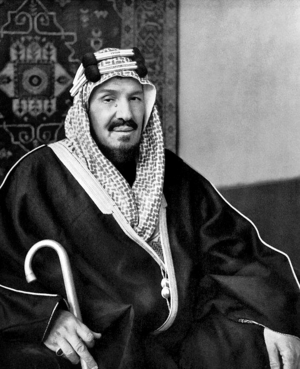
Prince Saud was born on 15 January 1902 in Kuwait City. He was the second son of Abdulaziz bin Abdul Rahman. His family was living in Kuwait after being exiled from Riyadh. When his father took over Riyadh in 1902, Saud moved there with his mother and brothers.
Saud's full brothers and sisters were Prince Turki, Prince Khalid, Prince Abdullah, and Princess Mounira. Khalid and Abdullah died when they were young. Their mother was Wadha bint Muhammad Al Orair. She was Abdulaziz's second wife. From the age of five, Saud studied Sharia (Islamic law) and the Quran. He also learned skills like archery and horse-riding. His father taught him about tribal history, peace agreements, and the art of war and politics.
Early Career and Royal Duties
Saud joined his father on many trips and battles. He helped unite the Arabian Peninsula. His first political task was at age thirteen. He led a group to Qatar. He fought in his first battle at Jarrab in 1915. He also fought at Yatab in the same year and Trubah in 1919. In 1925, he helped solve a problem in Mecca.
On 11 May 1933, Saud was officially named Crown Prince of Saudi Arabia. This news was shared in the Umm Al Qura newspaper. When he became crown prince, his father told him to spread Islam and care for his people. He also told him to listen to religious scholars. Saud promised his father he would follow this advice.
The next year, King Abdulaziz sent two military groups. Crown Prince Saud led one of them. He took back Najran and moved through the mountains in Yemen.
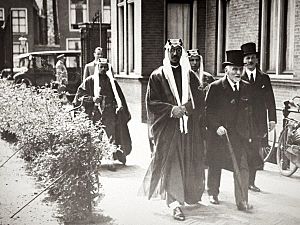
After the war with Yemen, Abdulaziz wanted Saud to travel more. Saud visited many places, including Transjordan, Palestine, Iraq, Egypt, and Europe. He represented his father at the coronation of King George VI in 1937. Saud became good friends with King Ghazi of Iraq. The Amir of Transjordan praised him for his Arabian qualities. Saud also visited Bahrain in 1937 to help solve problems between Bahrain and Qatar. He continued these visits until World War II began.
After the war, when a Jewish state in Palestine seemed likely, Arab leaders met in Egypt in 1946. Saud represented his father and country. They agreed that the Palestinian issue was important for all Arabs. In 1947, Saud visited the United States and met President Harry S. Truman. He also met leaders in Britain, France, and Italy. He shared his father's views on the rights of Palestinians.
After his travels, Saud focused on improving the country's finances and government. He sought advice from friendly countries, especially the US. The Saudi riyal was linked to the United States Dollar. A new Ministry of Finance was created. The Saudi Arabian Monetary Agency (SAMA), a central bank, was set up in 1952.
The first proper yearly state budget was made in 1948. After SAMA was created, the 1952 budget followed international rules. In 1952, 35 experts arrived to help with economic growth.
Prince Saud also suggested many important building projects. These included improving facilities for pilgrims, water supply, roads, and health services. He also focused on port improvements and higher education.
Plans for a paved road between Jeddah and Mecca were announced by Saud in 1947. He also started a project to bring water from Wadi Fatimah to Jeddah in November 1947. In 1950, the Mecca college was established. It later became Umm al-Qura University.
Many of these changes were called the "Crown Prince's Reforms." They were planned to be put into action after Abdulaziz's death in 1953. On 17 November 1952, the traditional Consultative Council in Mecca was expanded.
Earlier, on 19 October 1953, Abdulaziz made Crown Prince Saud the Prime Minister. This was for the first Saudi Cabinet. Before that, on 25 August 1953, he made him the Supreme Commander of the Armed Forces. During this time, the Armed Forces of Saudi Arabia were modernized with American help. Saudi Arabian Airlines also bought new planes to help pilgrims travel. On 10 June 1953, Saud laid the foundation stone for expanding the Prophet's Mosque in Medina.
King Saud's Reign
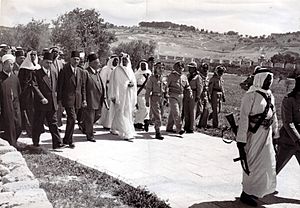
Saud became King on 9 November 1953 after his father Abdulaziz passed away. He became king during a time that was very different from when his father founded the Kingdom.
National Development
In his first speech as King, Saud told his ministers his goal. He said his father's rule was about military victories. But his own rule would be "a war on poverty, ignorance, and disease." He wanted to apply Islamic laws fairly to everyone. He also aimed to create a strong army.
To achieve these goals, he first doubled the number of ministries to ten in 1955. New ministries included education, agriculture, health, commerce, and industry. He also added two new departments for labor and broadcasting. In 1953, the decision was made to move ministries from Jeddah to Riyadh. This led to new buildings and housing for workers. This was a key moment for Riyadh's growth. Saud's half-brother, Crown Prince Faisal, became prime minister. He also kept his role as foreign minister. A five-year plan was started in 1954. King Saud also created the Grievance Board in 1954. This board became independent in 1955.
In January 1954, King Saud signed a deal with a Greek businessman. They planned to create a state-owned shipping company. However, this agreement was soon ended due to outside pressure.
In 1957, King Saud also founded King Saud University in Riyadh. He made clear the duties of cabinet ministers in May 1958. In 1960, he announced that schools would be built for girls. These schools would teach religious subjects and other useful sciences.
International Relations
King Saud played a very important role in regional and international politics. He began touring the world after visiting different parts of his own country. He visited Arab and friendly countries for important political reasons. He started his tour in 1954 in Egypt. He then visited Kuwait, Bahrain, Jordan, Yemen, and Pakistan.
He stated that his main goal was to "unify Muslims all over the world." He wanted them to be strong together. King Saud believed in not taking sides between the United States and the Soviet Union. He discussed this with Prime Minister Jawaharlal Nehru during a visit to India. He also worked to keep the region free from alliances that only served foreign interests. Because of this, he refused to join the Baghdad Pact.
In November 1955, King Saud gave a loan of 16 million dollars to Syria. He also agreed to trade products without special licenses or customs fees. When Israel attacked Jordan in 1955, King Saud invited military leaders from Egypt, Syria, Lebanon, and Jordan to Riyadh. They discussed how to stop the attacks. He agreed to pay for strengthening Jordan's National Guard and armed forces. He also supported the Algerian revolution against France. He helped them both politically and financially. King Saud asked people to donate money for the revolution. The donations reached $1,200,000. The government gave one million dollars of that amount in 1956. King Saud continued to support Algeria until it became independent in 1962.
Imam Ahmad bin Yahya of Yemen joined Arab efforts to unite. He signed a defense agreement with Egypt, Saudi Arabia, and Syria. This happened after he met King Saud, President Gamal Abdel Nasser, and President Shukri al-Quwatli in 1956.
King Saud continued to support Arab countries after Egypt took control of the Suez Canal Company in 1956. He strengthened his relationship with King Faisal II of Iraq after a meeting in Dammam in 1956. He also met with President Gamal Abdel Nasser and the Syrian President Shukri al-Quwatli. He confirmed his full support for Egypt during this crisis. When Britain, France, and Israel invaded Egypt in 1956, King Saud ordered a general call to arms. He opened offices for people to join the military.
He offered full help to the Egyptian government. He personally oversaw operations and welcomed Egyptian planes for safety. Many princes, including Fahd bin Abdulaziz and Salman bin Abdulaziz, joined the military. To pressure the British and French governments, he stopped oil exports to them. He banned all tankers carrying Saudi oil to these countries. He also ended relations with Britain and France.
King Saud used this economic tool for the first time. He knew it could affect his country's economy. He continued his support after the war to help Egypt recover. He gave large amounts of money, including 2 million Saudi riyals to the Egyptian Red Crescent. This was to help victims in Port Said.
King Saud wanted to keep the region free from political and defense alliances. He had strong ties with the American system because of oil. However, he thought about stopping American access to Dhahran airport. This was to pressure the United States.
Despite his country's close ties with the United States, he refused to join the American-backed Baghdad Pact of 1955. This pact aimed to stop the spread of Communism. Jordan and Syria were also encouraged not to join.
US President Dwight D. Eisenhower invited King Saud to visit the U.S. in 1957. Eisenhower believed King Saud was important in fighting communism in the Middle East. Before his visit, King Saud met with Presidents Gamal Abdel Nasser and Shukri al-Quwatli in Cairo. They agreed to ask Eisenhower to pressure Israel to leave occupied Sharm El Sheikh.
He continued to support countries at war with Israel. He signed a ten-year agreement with Egypt, Syria, and Jordan. This agreement helped ease Jordan's financial problems from the conflict. Egypt and Saudi Arabia each gave five million Egyptian pounds yearly.
He also discussed with the American President his disagreement with Britain over the Al Buraymi Oasis. This was an oil area between Saudi Arabia, Oman, and Abu Dhabi. The issue had been ongoing since his father's rule. After some clashes, the case went to international arbitration. When he accepted the American president's invitation, he received a good welcome. However, the Mayor of New York refused to welcome him due to his policies.
King Saud gave an important speech at a banquet hosted by Dag Hammarskjöld, the UN Secretary-General. He spoke about Arab complaints and the UN charter. He also discussed the effects of the Cold War. During his talks with the American president in Washington in 1957, Eisenhower explained his Eisenhower Doctrine. He expected King Saud to play a key role in fighting communism.
As part of this plan, Dwight D. Eisenhower offered a 25 million dollar loan to Saudi Arabia. King Saud explained that he had refused Soviet military aid to fight Britain. He stressed that "non-aligned" countries were getting more help from the Soviet Union than American allies were from the US. He believed American aid should increase. King Saud asked Eisenhower to pressure Israel to withdraw from occupied Palestinian lands. He also asked him to convince France to settle the independence of Algeria. In return, he promised to tell Arab leaders about the Eisenhower Doctrine. King Saud explained that much of his country's budget went to development. He needed military aid to fight Communism. The American government agreed to a 250 million dollar loan. They also offered weapons and training for the Saudi army.
In return, the American government could use Dhahran airport for five years. After that, it would be returned to Saudi Arabia in 1962.
Before telling his Arab peers about his visit, King Saud visited Spain, Morocco, Tunisia, and Libya. In February 1957, he met leaders from Egypt, Syria, and Jordan in Cairo. He told them about Eisenhower's goals. Influenced by Egyptian and Syrian presidents, King Saud decided to support their choice not to join the Eisenhower Doctrine. He wanted to maintain a united Arab front.
When Iraq tried to take over Kuwait in 1961, King Saud spoke out. He declared that "any action against Kuwait is an action against Saudi Arabia."
Struggle for Power
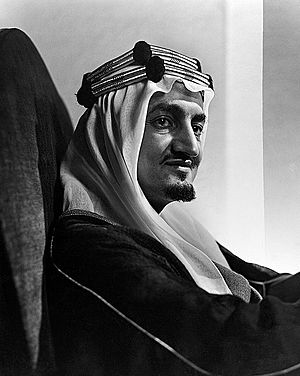
After Abdulaziz died, a struggle began between his two oldest living sons, Saud and Faisal. Even with more oil money, Saudi Arabia's debt grew. By 1958, it reached $450 million. The Saudi riyal lost half its value. Banks stopped lending money to Saudi Arabia. Saud stopped some government projects but kept spending on grand palaces.
In 1958, Saud had to give most of his power to Faisal. Saud and Faisal argued over who should do what in the government. Saud was often seen as wasteful with oil money and involved in plots. Faisal was seen as serious, religious, careful with money, and wanting to modernize.
The main argument was about the role of the Council of Ministers. Saud removed the Prime Minister's office. This made him both King and the main leader. Saud saw himself as both King and Prime Minister. Faisal wanted more power as Crown Prince and deputy prime minister.
King Saud's family worried about his spending and his inability to deal with Egypt's influence. Corruption and old ways weakened the government. Radio Cairo's anti-Saudi broadcasts were becoming popular.
King Saud and Prince Faisal continued their power struggle until 1962. Prince Faisal formed a new government while the King was away for medical treatment. Prince Faisal worked with Prince Fahd and Prince Sultan. Faisal's new government did not include Saud's sons. He promised ten reforms. These included writing a basic law, ending slavery, and creating a judicial council.
When King Saud returned, he rejected Faisal's new plan. He threatened to use the Royal Guard against his brother. Faisal then demanded that King Saud make him regent and give him all royal powers. He had the support of important Islamic scholars, called the ulema. They issued a fatwa (religious ruling) telling King Saud to agree.
King Saud refused. Faisal then ordered the National Guard to surround Saud's palace. In March 1964, Saud finally gave in. He named Faisal regent with full power. This made Saud a king with no real power. In November, the ulema, cabinet, and senior royal family members forced Saud to step down completely. Faisal then became king. At the same time, Prince Mohammed bin Abdulaziz was sent to King Saud's palace. He demanded loyalty from Saud and his sons to the new King Faisal. On 28 November 1964, it was announced that 11 of Saud's sons had pledged loyalty to King Faisal.
On 6 January 1965, Saud went to the palace with his uncle. He declared his loyalty to King Faisal.
Later Life and Passing
After these events, Saud left Saudi Arabia in January 1965. He lived in Geneva, Switzerland, and other European cities. He finally settled in Athens, Greece. Later, he tried to live in Beirut but was not successful. In 1966, Nasser invited Saud to live in Egypt. Another report says King Saud stayed in Egypt from 1966 to 1967. King Saud was also allowed to broadcast on Radio Cairo. Some of his sons, including Prince Khalid and Prince Mansour, joined him. They supported his attempt to get the throne back. However, after the 1967 Arab-Israel War, he lost Egypt's support. In October 1967, he left Egypt. He went to Vienna and then to Athens. He stayed there until his death on 23 February 1969.
Personal Life
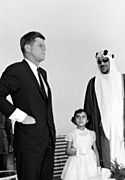
King Saud had many children. Only a few of them had public roles.
His oldest son, Fahd, was minister of defense from 1956 to 1960. His youngest child is Basmah bint Saud. His third son, Muhammed, was governor of Al Bahah Province for a time. He passed away in 2012. Prince Mishari took over as Al Bahah governor in 2010.
Another son, Mishaal, was the governor of Najran Province from 1996 to 2008. His son Abdul Rahman was a supporter of Al Nassr FC. One son, Badr bin Saud, was governor of Riyadh during his father's reign. Another son, Hussam, is a businessman.
One of his daughters, Hajer, died in 2011 after an illness. Her funeral prayer was held in Riyadh. Another daughter, Noura, was the mother of a former deputy defense minister. She died in 2013. Another daughter, Hessah, was the first Saudi woman to become a school principal. His daughter Fahda is an artist.
In 2001, his daughter Buniah (born 1960) was arrested in Florida. She was accused of assaulting her maid. She was released on bail and had to give up her passport. After his elder brother Turki died, Saud married Turki's wife, Muneera bint Obaid. Their daughter, Al Anoud, died in 2006 at age 83 and was buried in Mecca.
King Saud was described as tall, about six feet two inches. He had weak eyes like his father. But he also had his father's charming smile and a good sense of humor. These qualities helped him make many friends.
The "Red Palace," which King Abdulaziz built for King Saud and his mother, was opened to the public in 2019. It was Saudi Arabia's first concrete building. It now shows exhibits about his life.
Death and Funeral
King Saud passed away at age 67 on 23 February 1969 in Athens. He had a heart attack. Two days before his death, he felt unwell. He asked his doctor from Austria to examine him. However, the doctor arrived after he had died. On the morning of his death, Saud took a short walk on a beach with his daughter Nozhah. This was near the hotel where he lived. His body was taken to Mecca, then to Riyadh. The funeral ceremony took place at the Great Mosque in Mecca. He was buried next to his father's and grandfathers' graves at Al Oud cemetery in Riyadh.
Awards and Honors
| Styles of King Saud |
|
|---|---|
 |
|
| Reference style | His Majesty |
| Spoken style | Your Majesty |
After he became king, the Iranian ruler Mohammad Reza Pahlavi gave King Saud the highest award of Imperial Iran, the Order of Pahlavi.
During his time as king, Saud received many honors from different countries. In his official portraits, he wore symbols of these awards. Some of these included:
- Syrian Republic: Order of the Umayyads
- Lebanon: The Order of the Cedar of Lebanon
- Afghanistan: The Order of the Supreme Sun of Afghanistan
- Kingdom of Libya: The Order of Mohammed Ibn Ali El Senoussi.
- Hashemite Kingdom of Jordan: The Supreme Order of the Renaissance of Jordan.
- Spain: The Order of Civil Merit.
- Greece: The Order of Saint Mark.
- Egypt: The Collar of the Order of the Nile.
It was during King Saud's reign that Saudi Arabia started its own awards and medals. This happened in either 1954 or 1955. These awards included:
- The Order of King Abdulaziz Al Saud
- The Star of King Saud
- National Military Decoration
- Efficiency Medal
- Medal of Merit
- Medal of Duty
- Medal of Appreciation
- Long Service and Good Example Medal
- War Wounded Medal
- Palestine Medal
Images for kids
See also
 In Spanish: Saúd bin Abdulaziz para niños
In Spanish: Saúd bin Abdulaziz para niños
- List of things named after Saudi Kings


